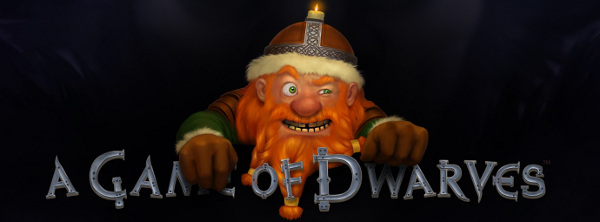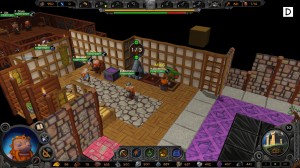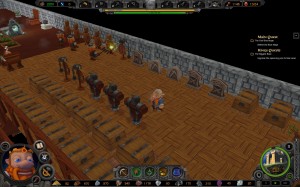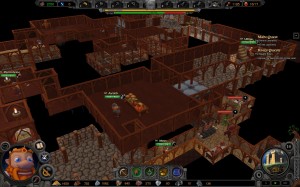A Game of Dwarves Review (PC)
- Updated: 4th Dec, 2012

A Game of Dwarves is about building. There’s a bit of dwarf-management in there, a bit of peril over here and a fair bit of luck all over when it comes to finding the right resources.
As the prince of a dwarf colony, it’s your job throughout the campaign to reclaim a series of fallen outposts across the country. Each outpost has a set of primary goals: Find the old trading tunnel, discover the 15 tablets of our former wisdom, and so on. The secondary goals are more mundane – build 3 stone statues, excavate 500 blocks – and are designed to show you how the game works, though this isn’t always clear.
 As with all dungeon-management games – and indeed, when establishing any sort of colony – you’re building a system. Starting out with a limit of 10 dwarves, you need to find the right balance of workers, military, diggers, crafters and research to keep everyone fed.
As with all dungeon-management games – and indeed, when establishing any sort of colony – you’re building a system. Starting out with a limit of 10 dwarves, you need to find the right balance of workers, military, diggers, crafters and research to keep everyone fed.
Your diggers are the only ones you can properly direct, marking cubes in the slightly fiddly 3D view for them to excavate. These guys will bring back the valuable resources that you can use to build or trade for gold.
The biggest factor you’ll need to account for is walking time. Dwarves need to sleep and eat, so it’s in your interests to provide beds and a dining table near the main hubs of activity – the military training dummies, the primary dig site and the gardens. I love this kind of system design – plant 6 bushes here, assign some dwarfs, create a surplus so that you can easily bring in another dwarf when required, but not too much or you’ll hit the storage cap.
 I also like creating little stories. When your dwarves die, they leave behind headstones. Sometimes I use them to line the hallway of the throne room, showing each dwarf that their home is built with the blood of their brethren. Sometimes I put them in the training area to motivate the guards. None of it has any effect on gameplay, but it keeps me entertained.
I also like creating little stories. When your dwarves die, they leave behind headstones. Sometimes I use them to line the hallway of the throne room, showing each dwarf that their home is built with the blood of their brethren. Sometimes I put them in the training area to motivate the guards. None of it has any effect on gameplay, but it keeps me entertained.
The main problem with A Game of Dwarves is that all the systems are rather superficial and the feedback is poor. Take the happiness bar, for example. You’re asked to build 3 stone statues because more decorations leads to happier dwarfs. But as far as I can tell, the only benefit this brings is that new dwarves spawn more quickly when you request them. Given that dwarves only die from starvation or combat, it’s a benefit you’ll rarely need. I believe that non-dwarven items that you come across actually lower your colony’s happiness, but there’s no way to examine them for confirmation.
Equally, there’s a strange balance in the economy between resources, happiness and cosmetic design. Rounded beds are unlocked at some mystery point during each level (there’s that lack of feedback again). These use rarer materials, yet provide the same level of comfort and happiness as the Comfy bed and have a similar art style. You’ve little incentive to use them. Extra items have been made available in the online shop, which helps a little on the cosmetic side but the resource-balancing issue is still there.
While you’re busy digging and paving, your lab dwarves should be beavering away at the research bench to unlock new armour and better lighting. However, since you only get the Tier 2 skills when you’ve purchased everything in Tier 1, there’s no specialisation involved and no variation in gameplay. The unlocks don’t even carry across campaign levels, so you’re simply unlocking the same dozen skills over and over again.
Discovery could have been a big draw for the game, but the balance in campaign mode is so unpredictable that you could be forgiven for setting up a small upper dungeon and then walking away for 6 hours while your dwarven militia train up. In the fourth level, I encountered dozens of rooms with level 2 gnomes and level 7 goblins, each once boosting my confidence that I had paced my progress correctly. Perhaps I’d even overdone it a little with my troupe of level 14 dwarves.
On reaching the goal room, I was beset by a level 85 mage. Yup, level 85. We did get him down to half health, but we had no real chance. Since the mage blew straight through my reinforced walls, I eventually saved the colony by removing a set of stairs and a bridge, thus preventing my freshly formed militia from charging headlong into suicide. Hardly a satisfying tactic.
 For people who would rather create than follow a story, many of these problems can be worked around by simply ignoring the campaign and playing in custom mode. You can dig away to your heart’s content, creating the most amazing caverns and networks without all the block-by-block tedium of Minecraft.
For people who would rather create than follow a story, many of these problems can be worked around by simply ignoring the campaign and playing in custom mode. You can dig away to your heart’s content, creating the most amazing caverns and networks without all the block-by-block tedium of Minecraft.
Navigating the Z-axis can get a little fiddly but given that you can pause and rotate the map, it’s forgivable. More awkward is the need to keep scrolling up and down to find your beds and guard posts as the dig site progresses, or just give up and build redundant dining tables because you can’t figure out which twisty corridor the last one was left in. It would really help to have navigation markers that you can place and zoom to at the touch of a button.
A Game of Dwarves isn’t for everyone. It’s not the kind of game that leads to amazing stories or makes you weep but it is a satisfying dungeon builder with enough depth to keep you going for a while, despite its flaws. Also, it’s really cheap.
You can buy A Game of Dwarves now on Steam.


Follow Us!